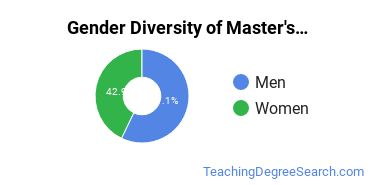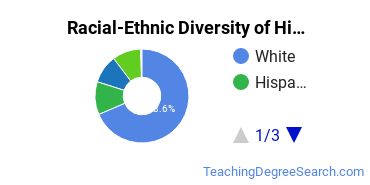Master’s Degrees in History Education
Education Levels of History Teacher Education Majors
During the most recent year for which data is available, 216 people earned their master's degree in history teacher education. This earns it the #55 spot on the list of the most popular master's degree programs in the nation.
The following table shows the number of diplomas awarded in history teacher education at each degree level.
| Education Level | Number of Grads |
|---|---|
| Bachelor’s Degree | 594 |
| Master’s Degree | 216 |
| Associate Degree | 17 |
| Graduate Certificate | 7 |
Earnings of History Teacher Education Majors With Master’s Degrees
At this time, we do not have the data to estimate the median earnings for this class of people.
Student Debt
We do not have the data to estimate the median debt for this class of people.
Student Diversity
More men than women pursue master's degrees in history teacher education. About 50.9% of graduates in this field are male.
| Gender | Number of Grads |
|---|---|
| Men | 110 |
| Women | 106 |

The racial-ethnic distribution of history teacher education master’s degree students is as follows:
| Race/Ethnicity | Number of Grads |
|---|---|
| Asian | 3 |
| Black or African American | 16 |
| Hispanic or Latino | 35 |
| White | 141 |
| International Students | 0 |
| Other Races/Ethnicities | 21 |

Most Popular History Teacher Education Programs for Master’s Degrees
There are 40 colleges that offer a master’s degree in history teacher education. Learn more about the most popular 20 below:
The most popular school in the United States for history teacher education students seekinga master's degree is Grand Canyon University. Each year, around 103,400 students seeking various degrees attend the university. The average in-state tuition for full-time undergraduates is $16,390 per year, while in-state graduate students, on average, pay $10,138 per year. During the most recent year for which we have data, 97 people received their master's degree in history teacher education from Grand Canyon University. Of these students, 50% were women and 32% were members of underrepresented racial-ethnic groups.
The 2nd most popular school in the country for history teacher education majors who are seeking their master's degree is Liberty University. Each year, around 93,300 students seeking various degrees attend the university. The average in-state tuition for full-time undergraduates is $15,015 per year, while in-state graduate students, on average, pay $7,740 per year. During the most recent year for which we have data, 41 people received their master's degree in history teacher education from Liberty University. Around 19% of these students were from an underrepresented racial-ethnic group, and 58% were women.
The 3rd most popular school in the country for history teacher education majors who are seeking their master's degree is Piedmont College. The average in-state tuition for full-time undergraduates is $30,200 per year, while in-state graduate students, on average, pay $11,700 per year. During the most recent year for which we have data, 10 people received their master's degree in history teacher education from Piedmont College.
Salem State University comes in at #4 on our list of the most popular colleges offering master's degrees in history teacher education. Roughly 7,200 attend the school each year. The average in-state tuition for full-time undergraduates is $910 per year, while in-state graduate students, on average, pay $2,520 per year. During the most recent year for which we have data, 7 people received their master's degree in history teacher education from Salem State.
DePaul University is the 5th most popular school in the nation for students seeking a master's degree in history teacher education. Each year, around 21,900 students seeking various degrees attend the university. The average in-state tuition for full-time undergraduates is $43,379 per year, while in-state graduate students, on average, pay $22,135 per year. During the most recent year for which we have data, 6 people received their master's degree in history teacher education from DePaul. About 38% of this group were women, and 25% were students from an underrepresented racial-ethnic group.
The 5th most popular school in the country for history teacher education majors who are seeking their master's degree is Merrimack College. Roughly 5,400 attend the school each year. The average in-state tuition for full-time undergraduates is $47,636 per year, while in-state graduate students, on average, pay $34,208 per year. During the most recent year for which we have data, 6 people received their master's degree in history teacher education from Merrimack. Of these students, 50% were women and 21% were members of underrepresented racial-ethnic groups.
University of Illinois at Chicago comes in at #7 on our list of the most popular colleges offering master's degrees in history teacher education. Each year, around 33,500 students seeking various degrees attend the university. The average in-state tuition for full-time undergraduates is $12,656 per year, while in-state graduate students, on average, pay $14,108 per year. During the most recent year for which we have data, 5 people received their master's degree in history teacher education from UIC. Of these students, 38% were women and 13% were members of underrepresented racial-ethnic groups.
Lesley University is the 7th most popular school in the nation for students seeking a master's degree in history teacher education. Each year, around 4,200 students seeking various degrees attend the university. The average in-state tuition for full-time undergraduates is $31,890 per year, while in-state graduate students, on average, pay $19,350 per year. During the most recent year for which we have data, 5 people received their master's degree in history teacher education from Lesley. Around 33% of these students were from an underrepresented racial-ethnic group, and 33% were women.
The 9th most popular school in the country for history teacher education majors who are seeking their master's degree is Bridgewater State University. Each year, around 10,600 students seeking various degrees attend the university. The average in-state tuition for full-time undergraduates is $910 per year, while in-state graduate students, on average, pay $1,260 per year. During the most recent year for which we have data, 4 people received their master's degree in history teacher education from Bridgewater State.
Lee University comes in at #9 on our list of the most popular colleges offering master's degrees in history teacher education. The average in-state tuition for full-time undergraduates is $21,960 per year, while in-state graduate students, on average, pay $16,470 per year. During the most recent year for which we have data, 4 people received their master's degree in history teacher education from Lee University.
Gordon College comes in at #11 on our list of the most popular colleges offering master's degrees in history teacher education. Each year, around 1,800 students seeking various degrees attend the university. The average in-state tuition for full-time undergraduates is $27,000 per year, while in-state graduate students, on average, pay $7,955 per year. During the most recent year for which we have data, 3 people received their master's degree in history teacher education from Gordon College.
The 14th most popular school in the country for history teacher education majors who are seeking their master's degree is Hastings College. The average in-state tuition for full-time undergraduates is $33,950 per year, while in-state graduate students, on average, pay $11,400 per year. During the most recent year for which we have data, 1 people received their master's degree in history teacher education from Hastings.
Explore Major by State
Alabama
Arkansas
Connecticut
Florida
Idaho
Iowa
Louisiana
Massachusetts
Mississippi
Nebraska
New Jersey
North Carolina
Oklahoma
Rhode Island
Tennessee
Vermont
West Virginia
Related Majors
Below are some popular majors that are similar to history teacher education that offer master’s degrees.
| Major | Annual Degrees Awarded |
|---|---|
| Reading Education | 4,837 |
| Mathematics Education | 1,666 |
| Physical Education & Coaching | 1,554 |
| Other Teacher Education | 1,261 |
| Music Education | 1,142 |
References
*The racial-ethnic minority student count is calculated by taking the total number of students and subtracting white students, international students, and students whose race/ethnicity was unknown. This number is then divided by the total number of students at the school to obtain the percentage of racial-ethnic minorities.
- College Factual
- National Center for Education Statistics
- O*NET Online
- Bureau of Labor Statistics
- Image Credit: By Aparajita Datta under License
More about our data sources and methodologies.










